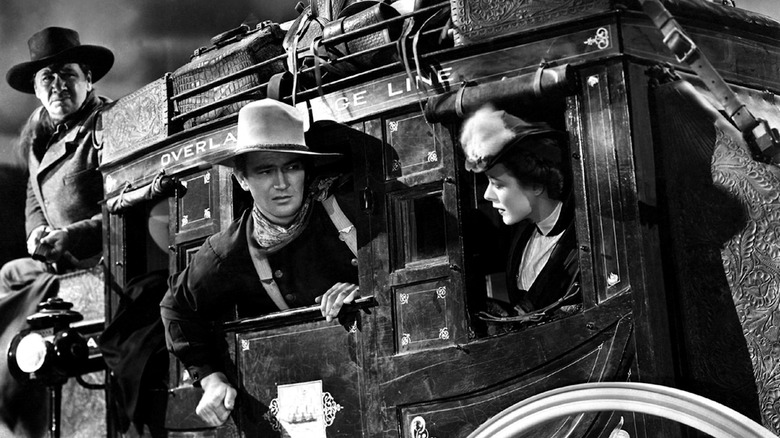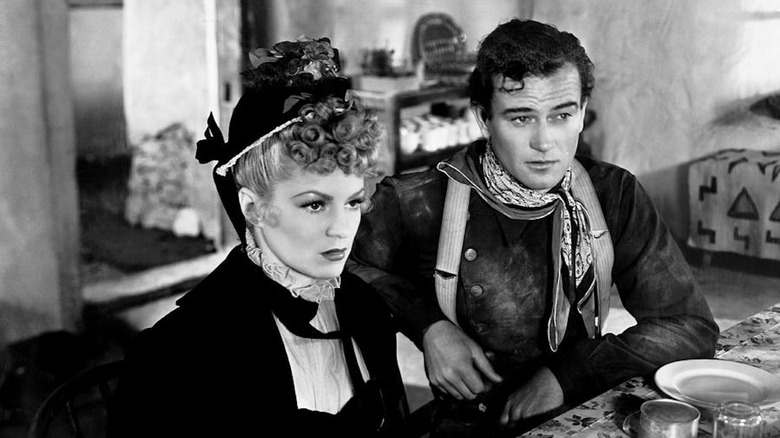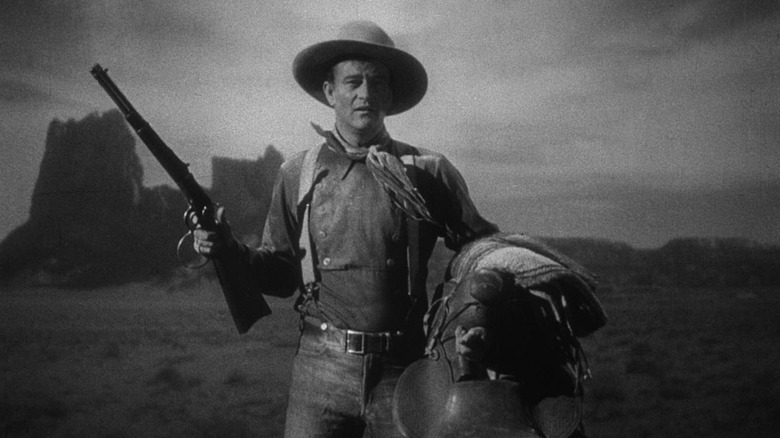John Wayne's Stagecoach Performance Was Pulled Out Of Him By Force
John Ford was entering the prime of his career in 1939 when he directed what many believe to be the most artistically significant Western in the history of cinema. "Stagecoach" is no mere shoot-em-up. It was the first of many films John Ford would shoot in Monument Valley, and he uses the grand location to stirringly mythic effect. No Western had ever felt this big or this charged with rollicking incident. It is a thrilling adventure filled out by a fabulous ensemble, but it is anchored by a seemingly limited actor who'd thus far been relegated to B movies.
Ford had worked with John Wayne before, but the director waited for the actor to age a bit before he promoted him to the top of the bill. He felt he was taking a chance on The Duke. He looked the part, but could he rise to the mythic occasion? While Ford's casting instincts proved correct, he decided the only way he could get the right, rugged performance out of Wayne was to ride his star as hard as possible. And, boy, did he make The Duke's life miserable.
Taking it to The Duke
According to Ronald L. Davis' "Duke: The Life and Image of John Wayne," Ford "berated and bullied" the actor throughout the first three weeks of shooting:
"Stop slurring your dialogue and show some expression," the director yelled. He called Wayne "a big oaf" and "a dumb bastard" in front of the actors and crew. "I really should get Gary Cooper for this part," Ford muttered in disgust. "Can't you even walk, instead of skipping like a goddamn fairy?" the director shouted at Duke. Claire Trevor remembered Ford's grabbing Wayne by the chin and shaking his head: "Why are you moving your mouth so much?" the director demanded. "Don't you know that you don't act with your mouth in pictures? You act with your eyes!"
Wayne did not yet have the stature to hit back at his director, but even if he had, he respected Ford way too much to question his methods. "He would turn me inside out," said Wayne. "I would want to murder him. But Ford knew what he was doing... He knew I was ashamed of being a B Western cowboy in the company of these big stars."
Ford's approach worked brilliantly. The rest of the cast eventually felt sorry for Wayne, which prompted them to do everything possible to prop the soon-to-be star up whenever they shared the screen with him. Their efforts, along with Wayne's indomitable presence, carried the day. "Stagecoach" opened to rave reviews, and was a decent-sized hit for United Artists.
The don't make 'em like they used to
It is impossible to imagine a director in this day and age attempting to browbeat a performance out of an actor, which is, of course, a good thing. But while Wayne didn't enjoy Ford's directorial style at the time, he came to appreciate the lengths to which his longtime collaborator went on "Stagecoach." "Nobody could handle actors and crew like Jack," said Wayne. "He was probably the finest artist I've ever known."
When Ford returned from World War II in the mid-1940s, he transformed Wayne from a movie star into a cultural icon. In films like "Fort Apache," "She Wore a Yellow Ribbon," and "The Searchers," The Duke came to epitomize everything that was fine and downright awful about the white American male. Though neither man would ever cop to any type of subversion, the movies speak for themselves. Regardless of what you think of Ford and Wayne as people, there has never been a more fascinatingly complex director-actor duo.


